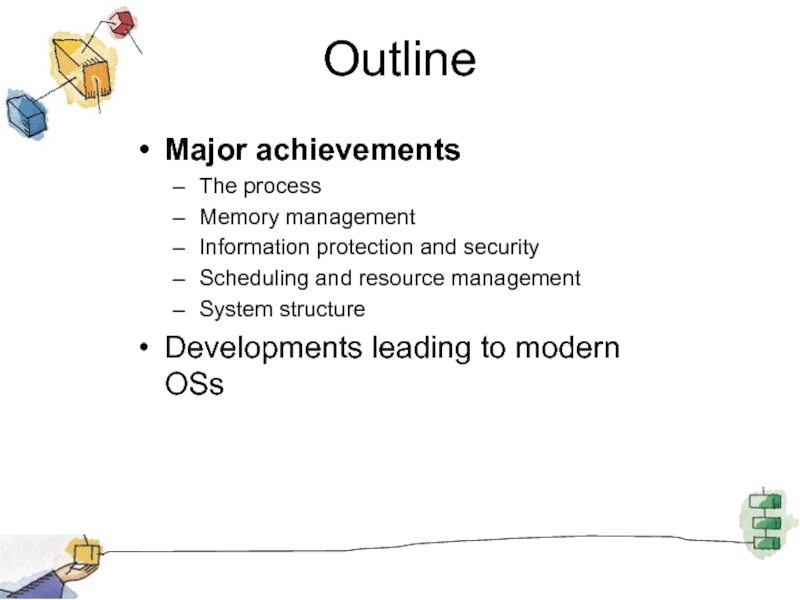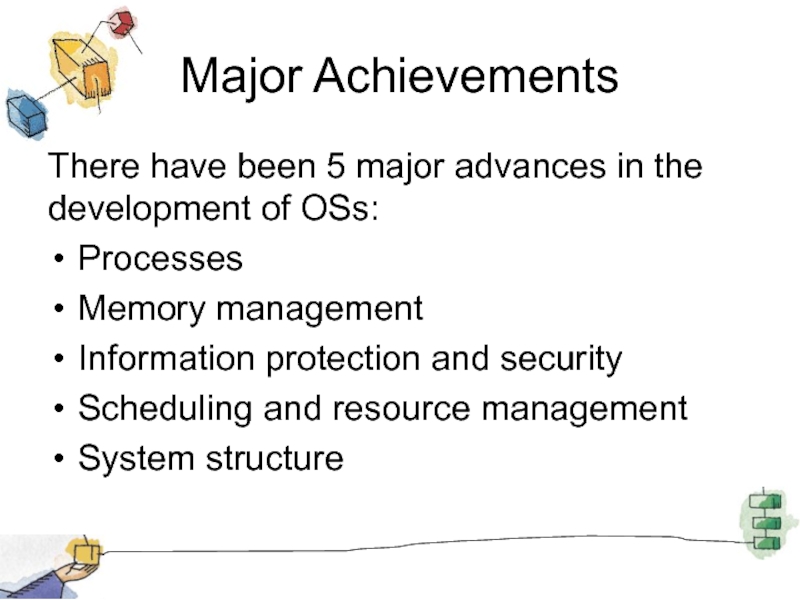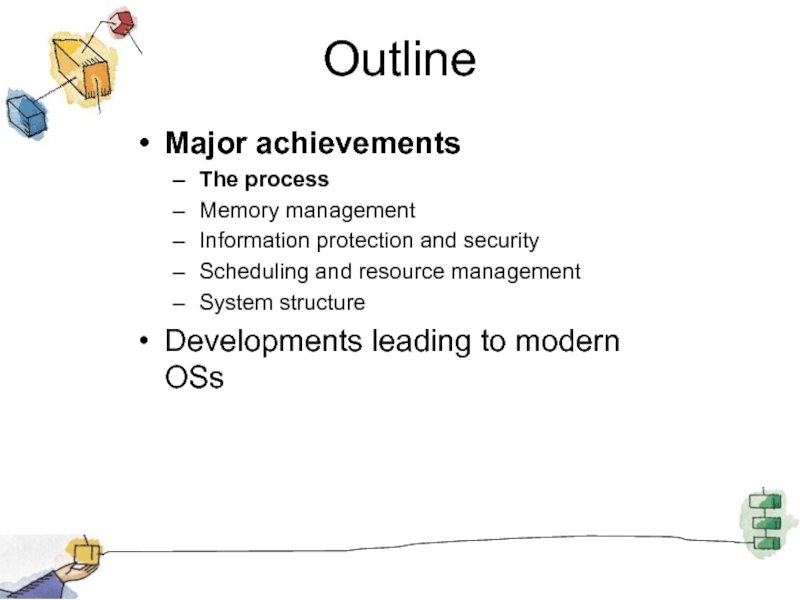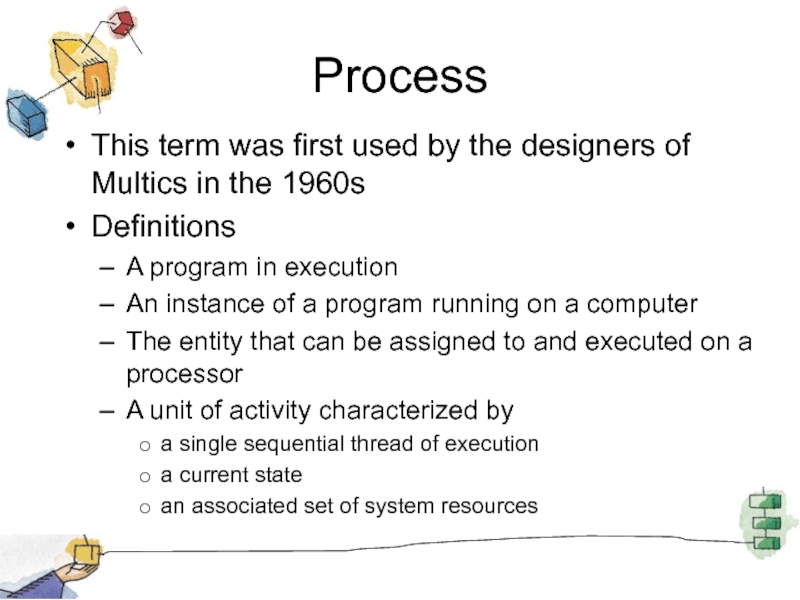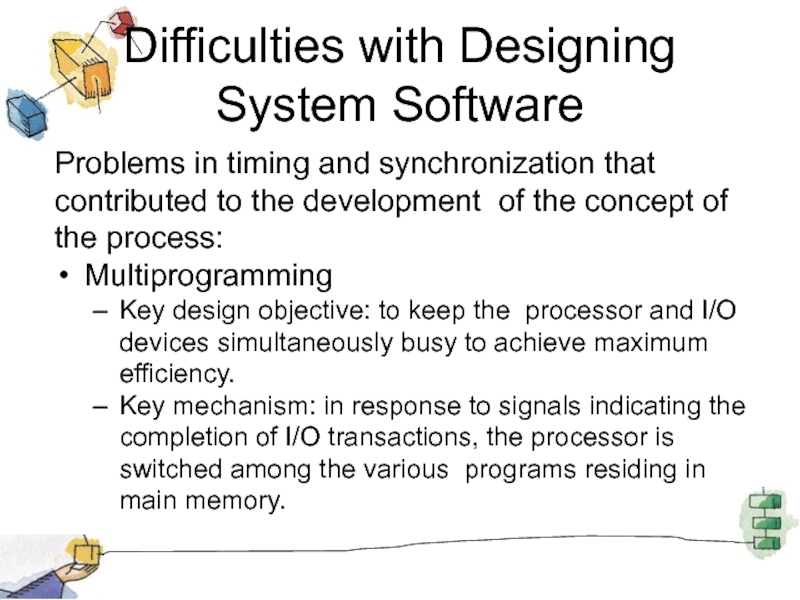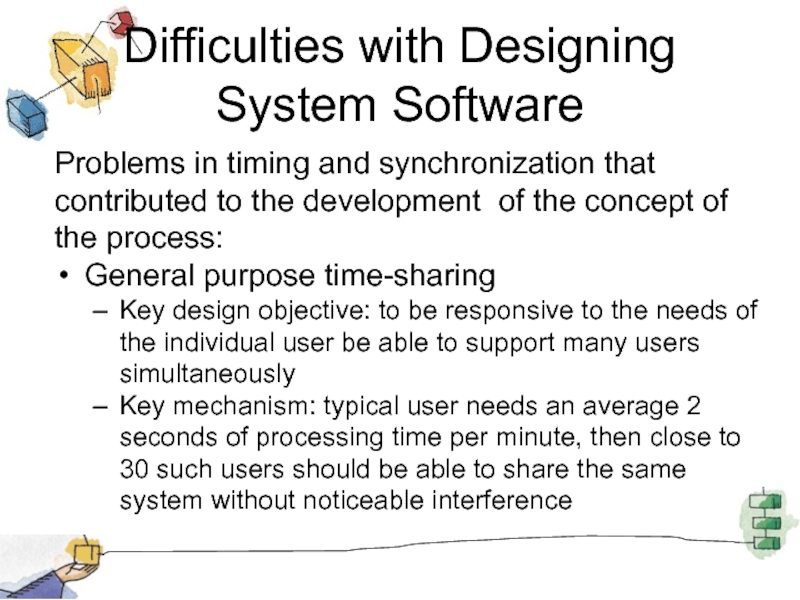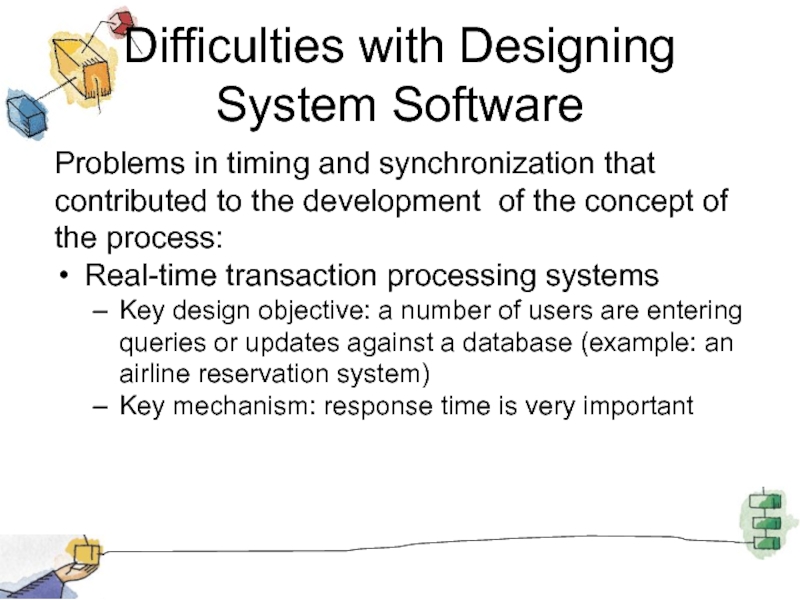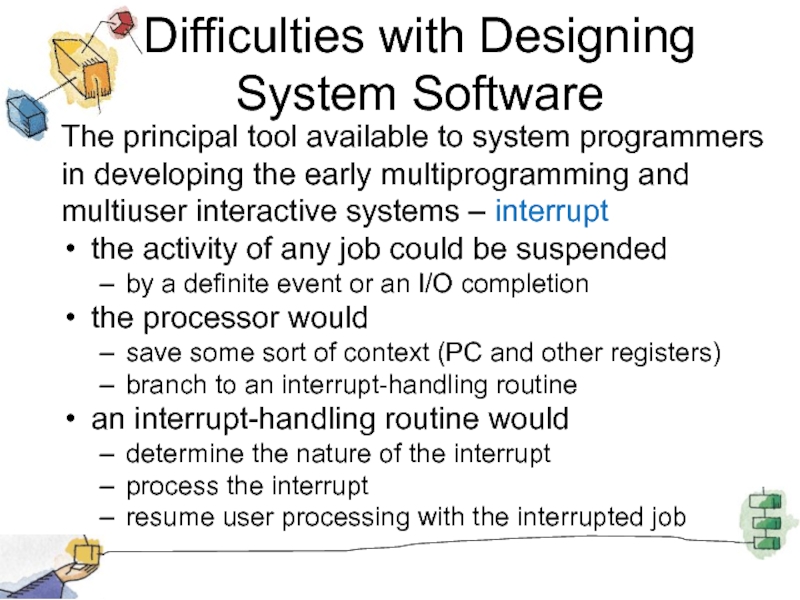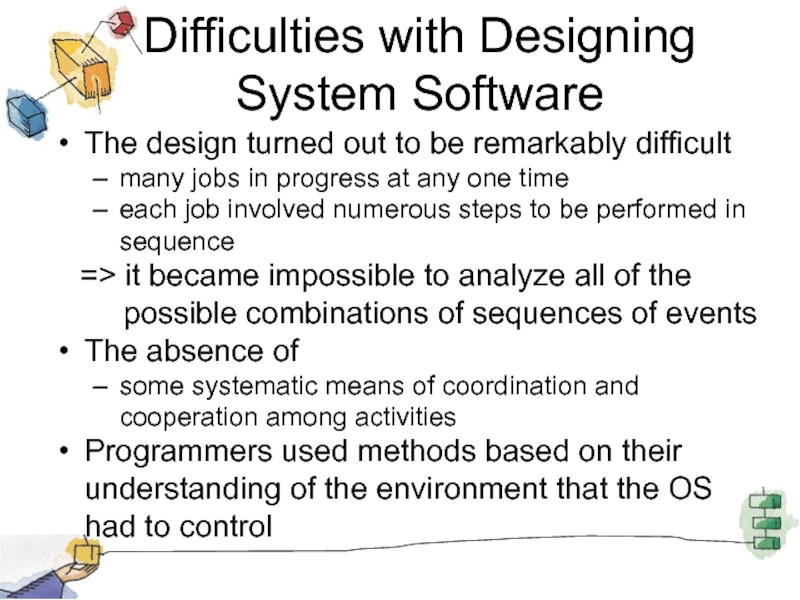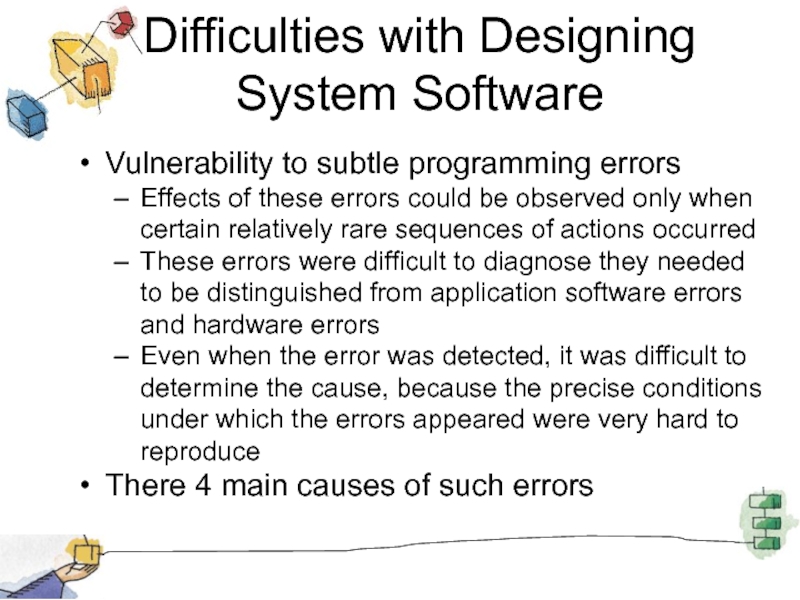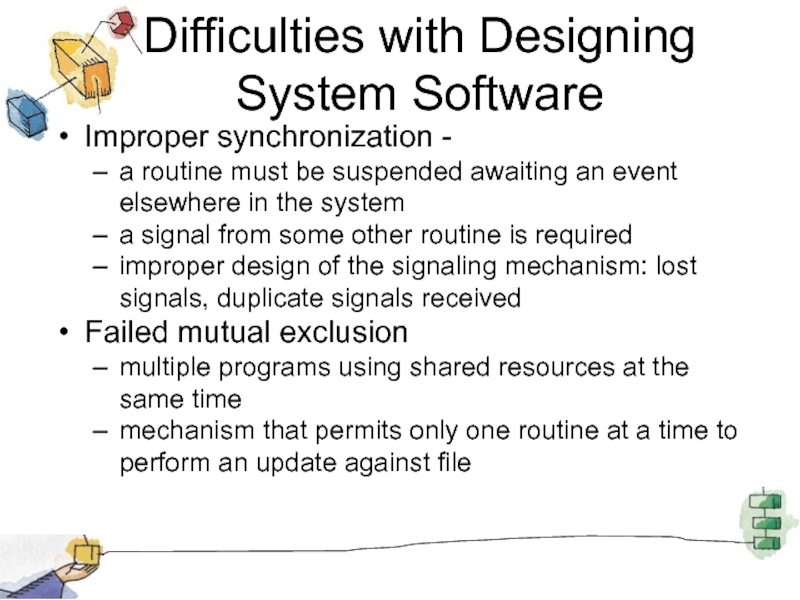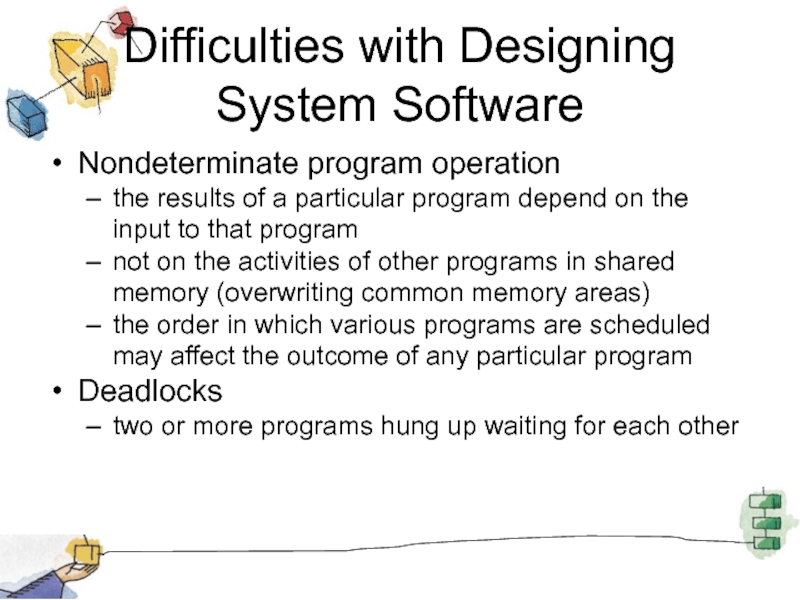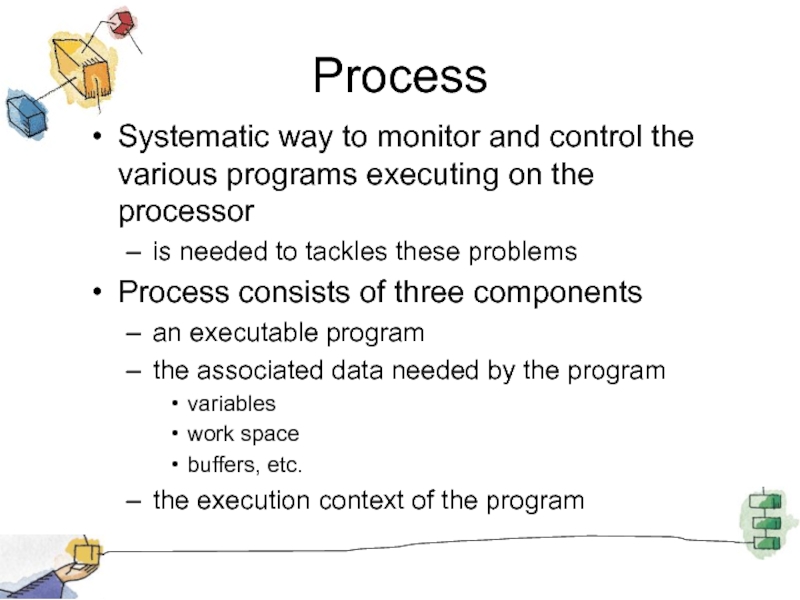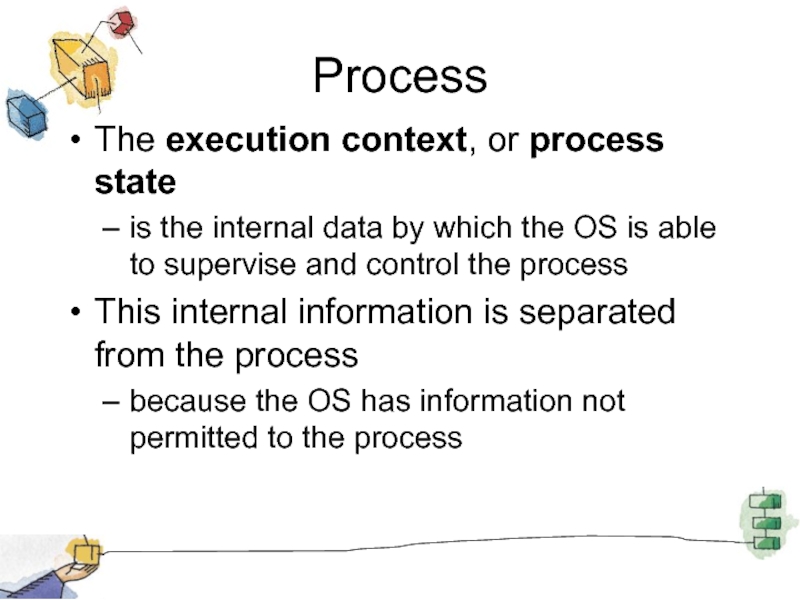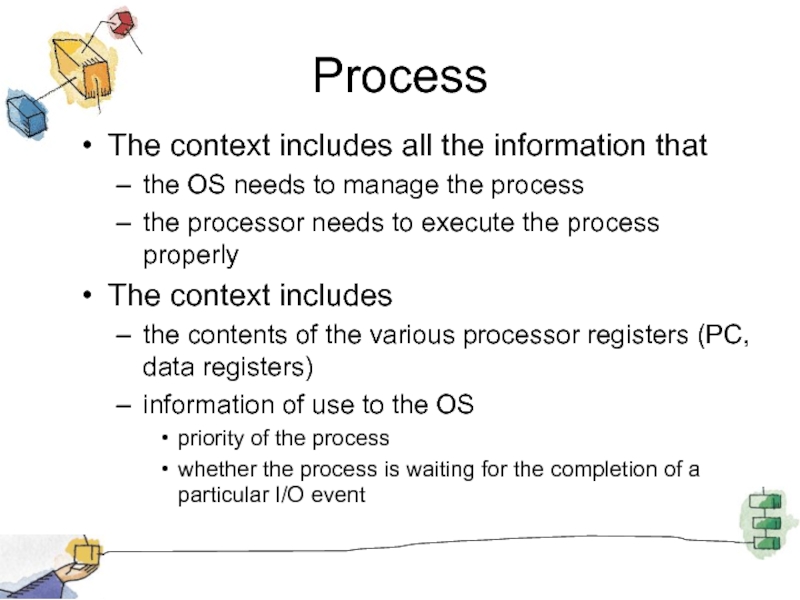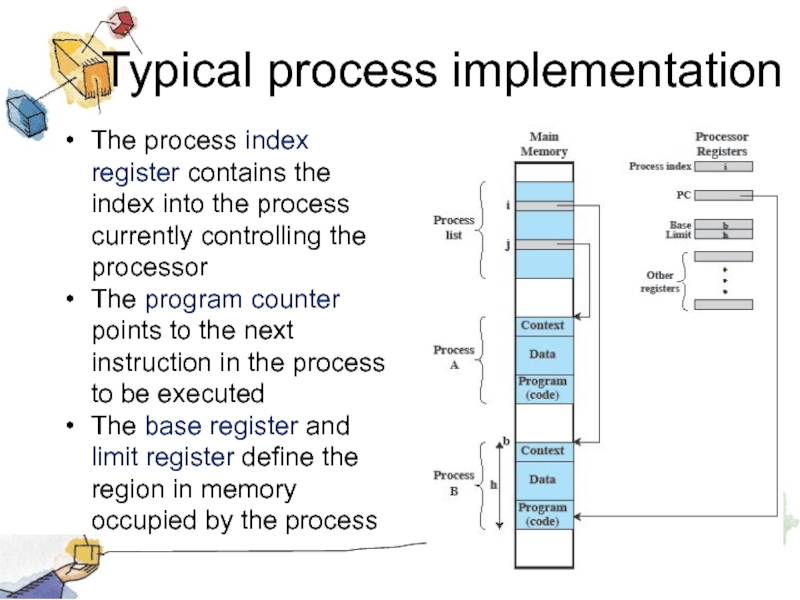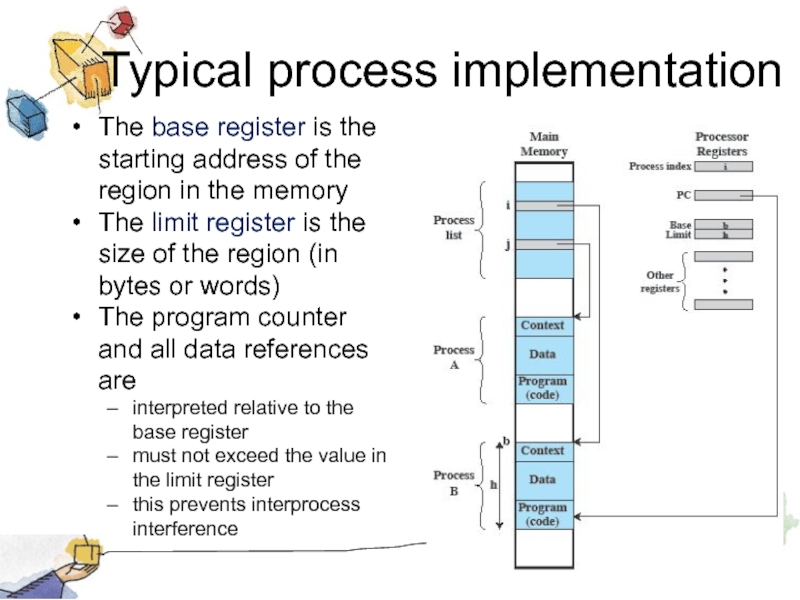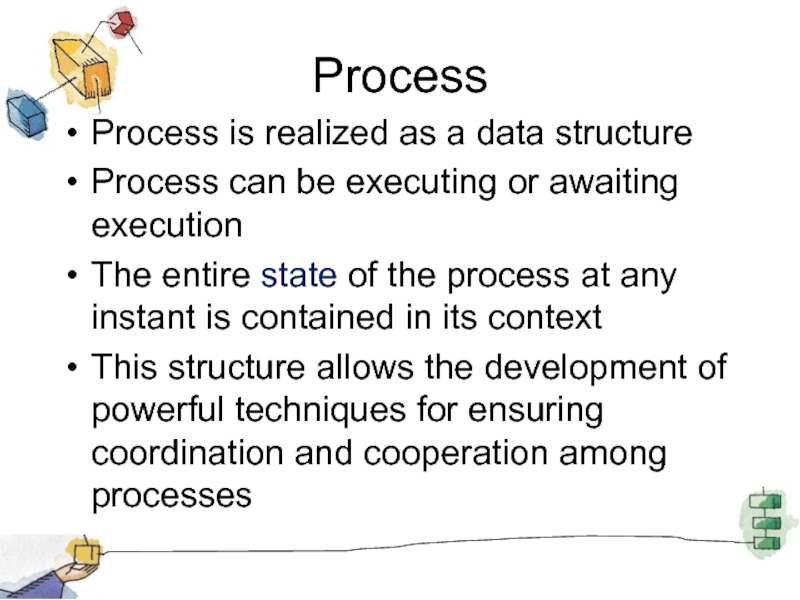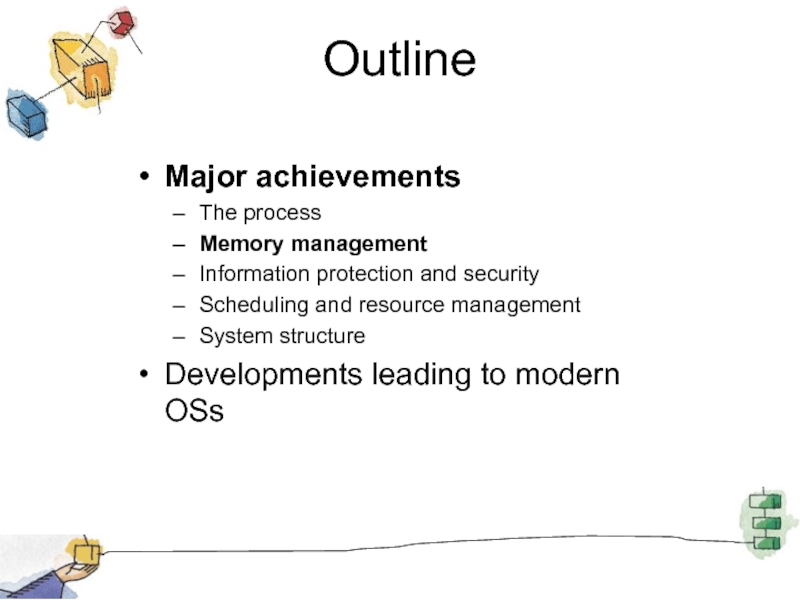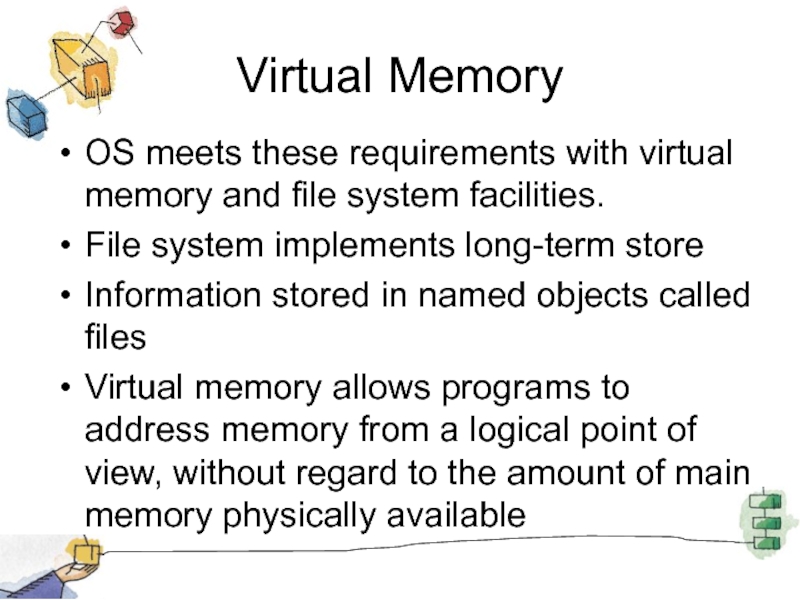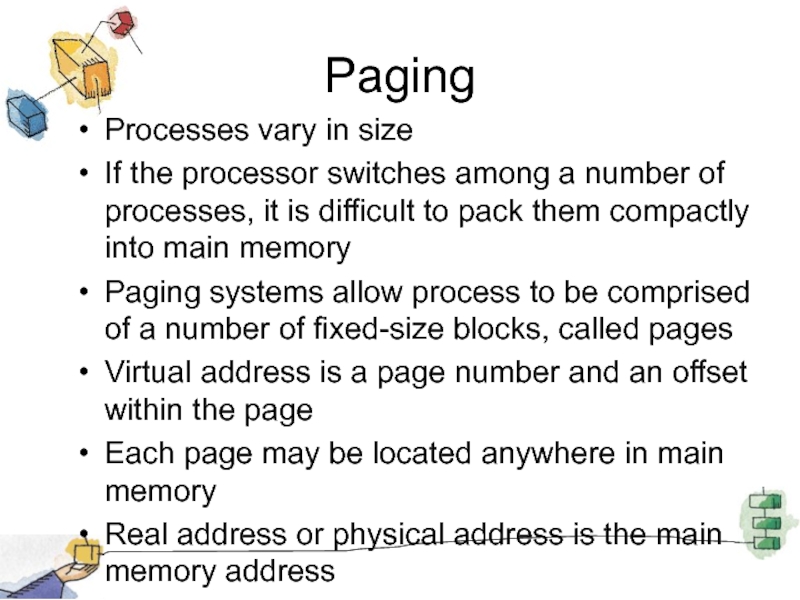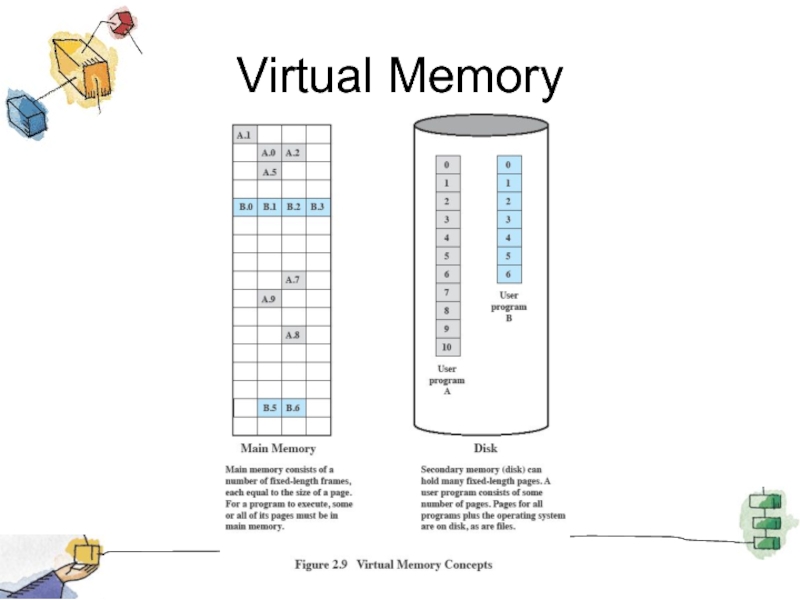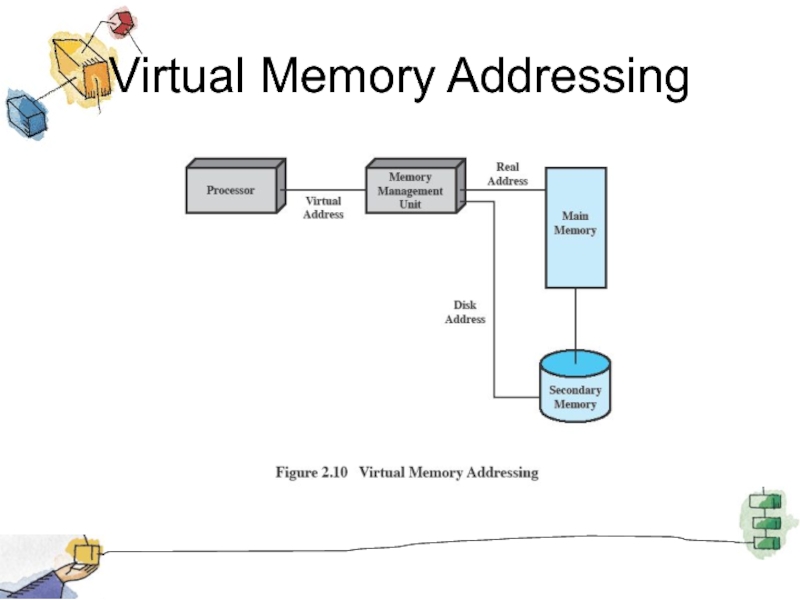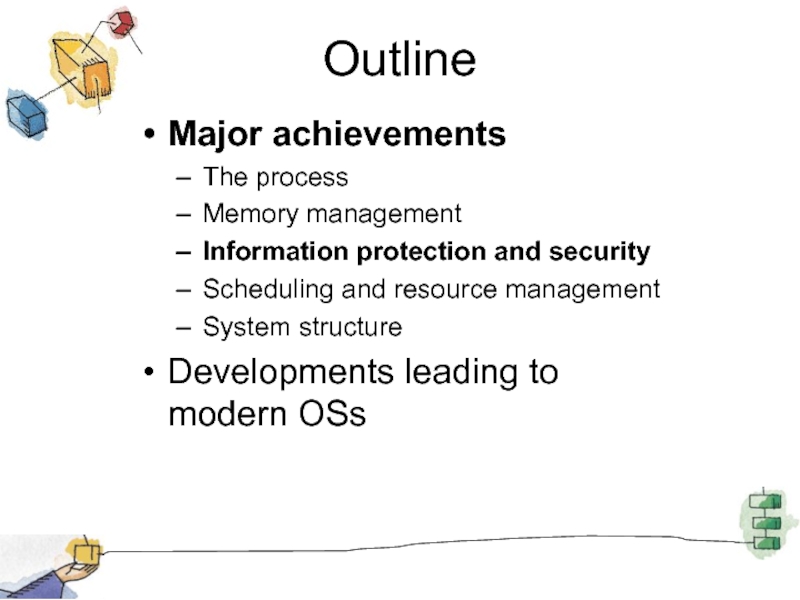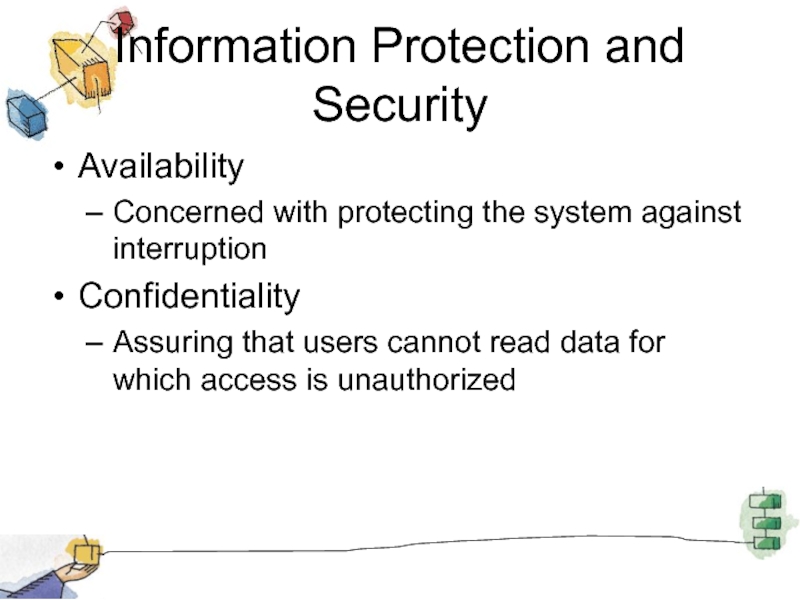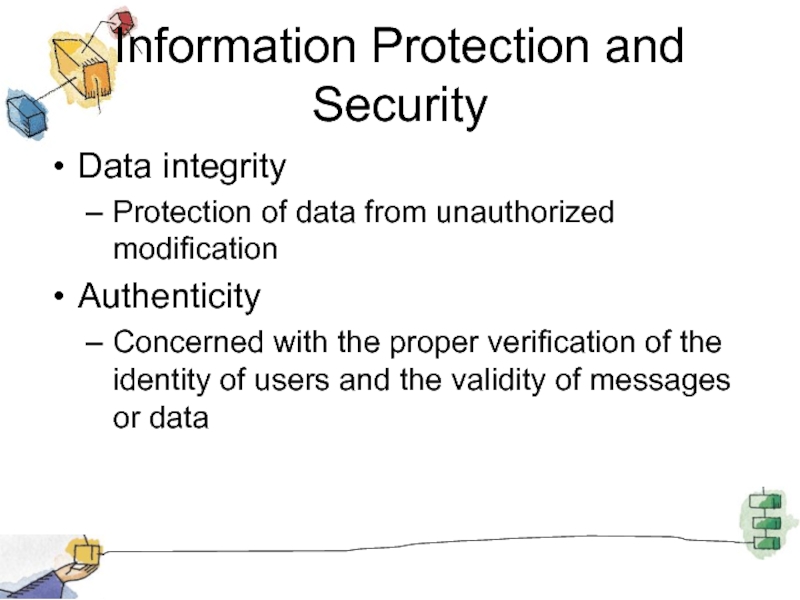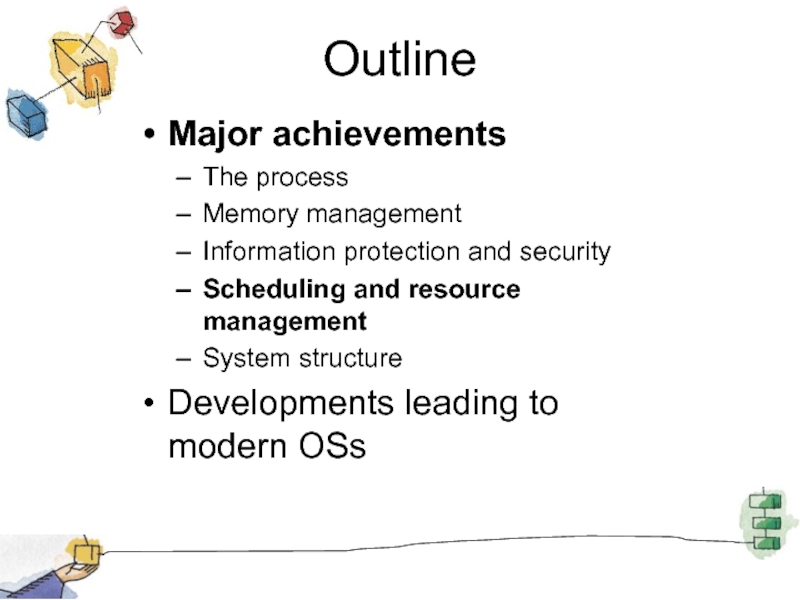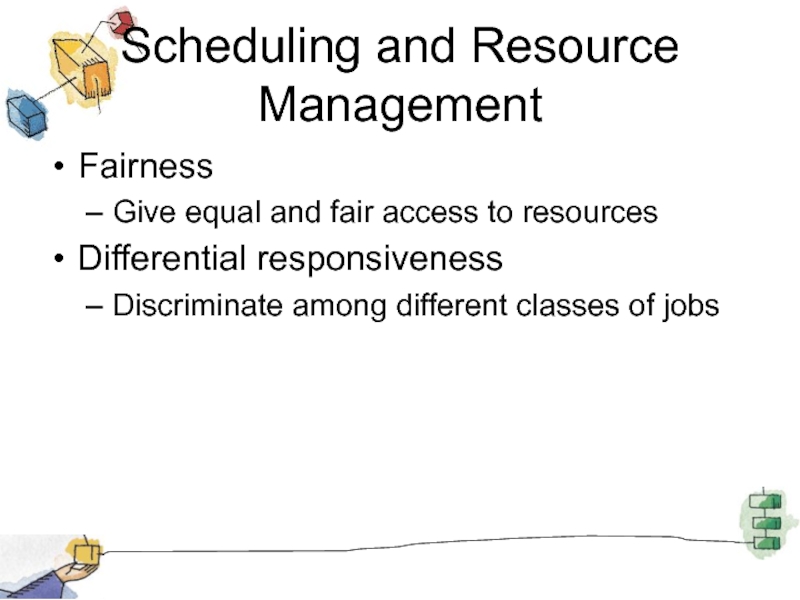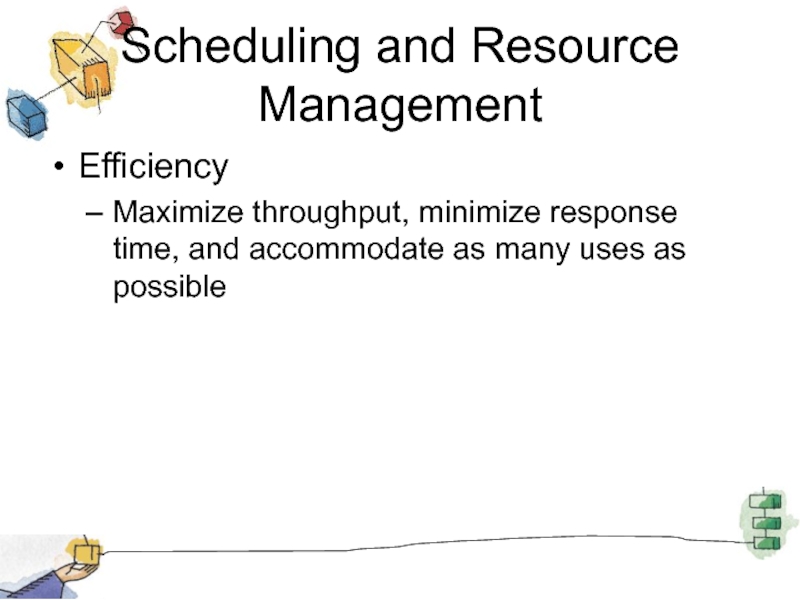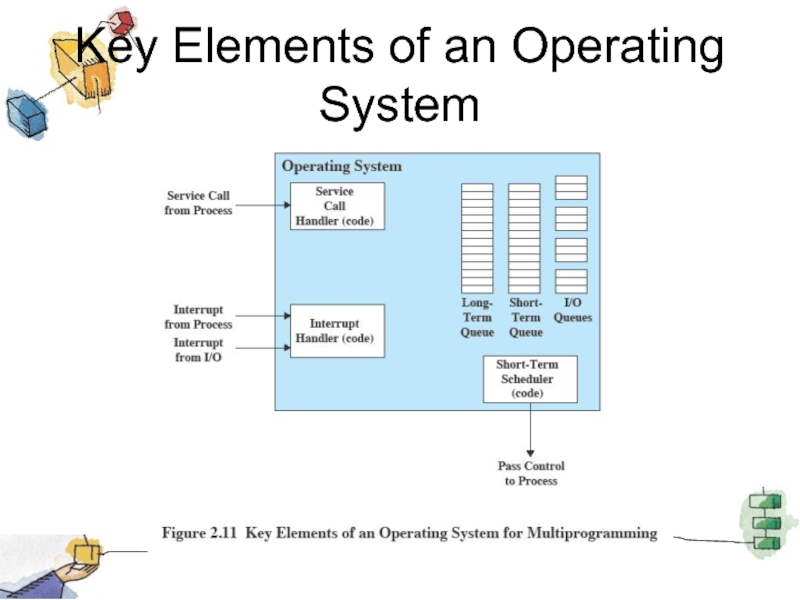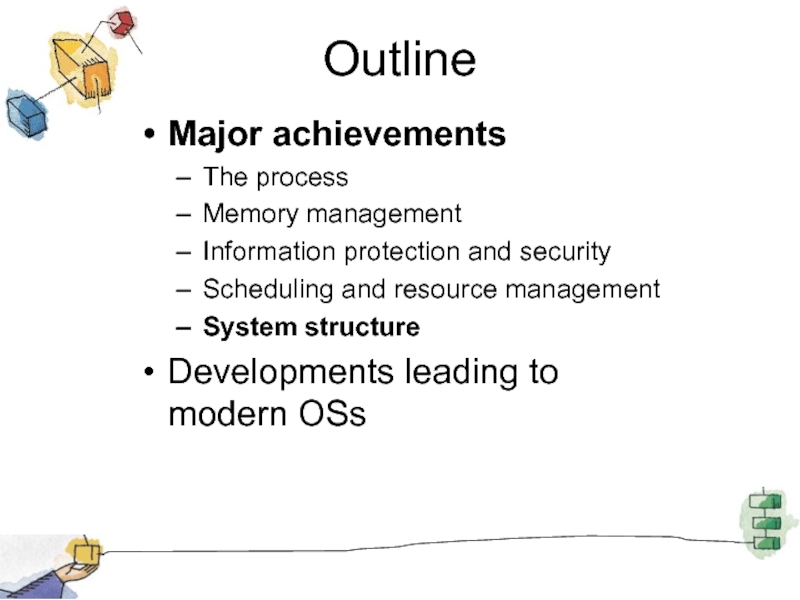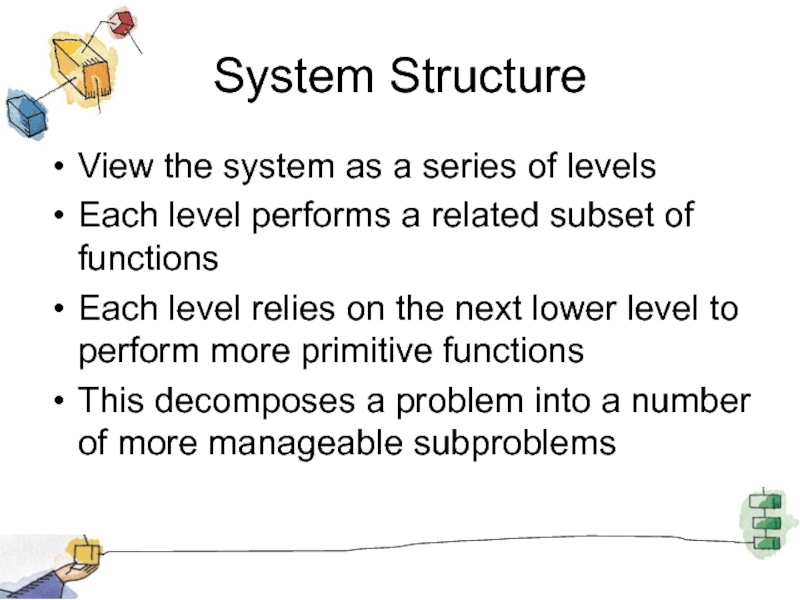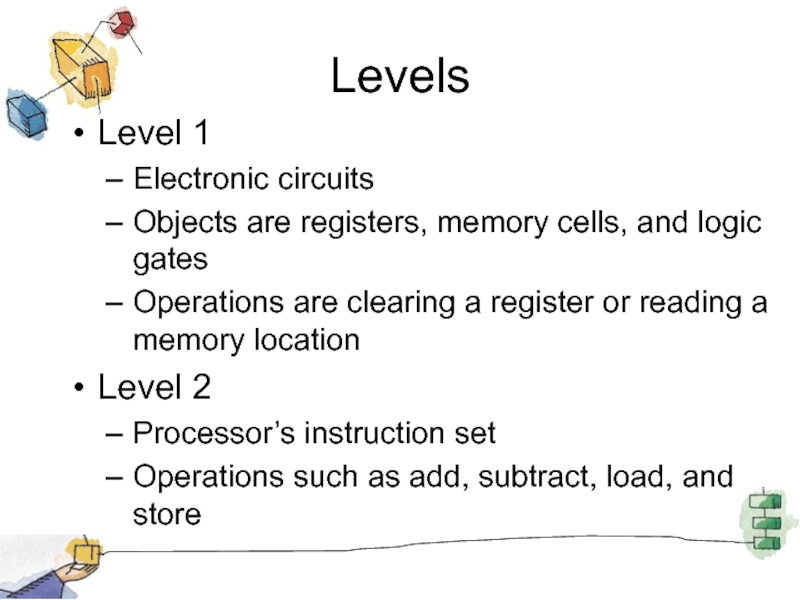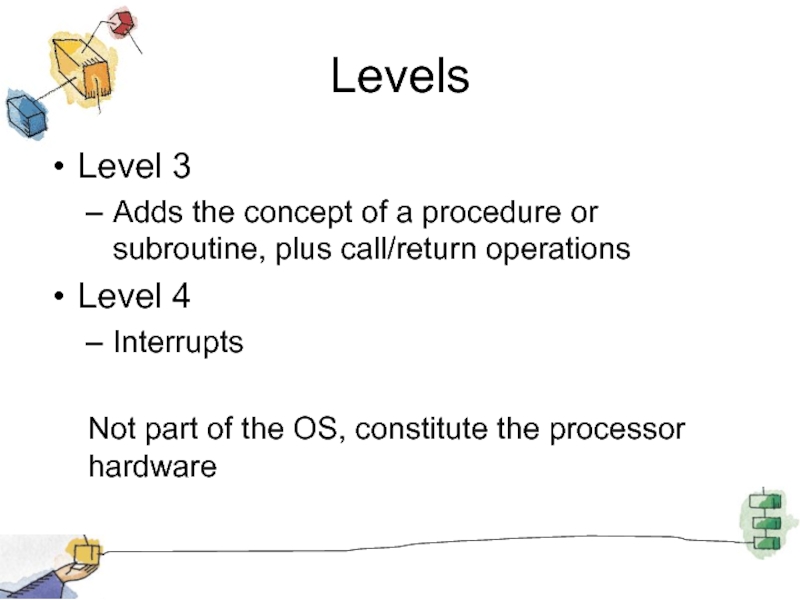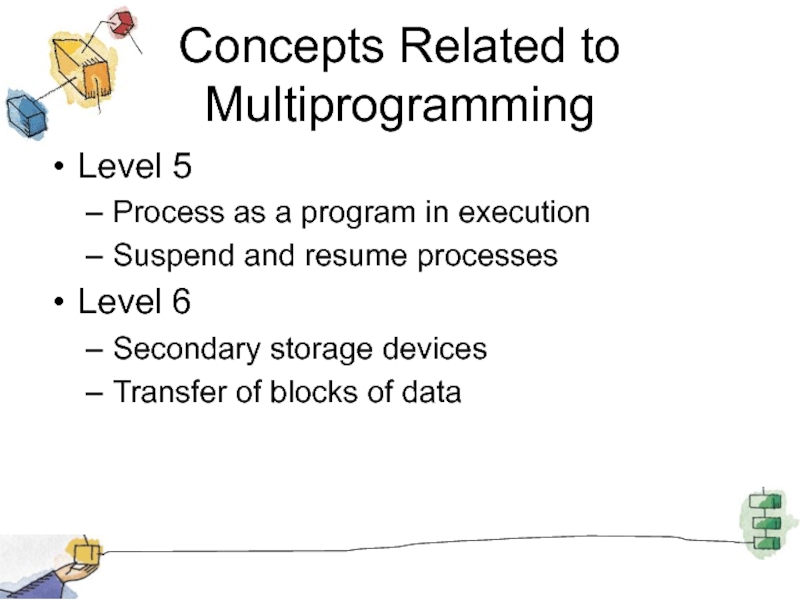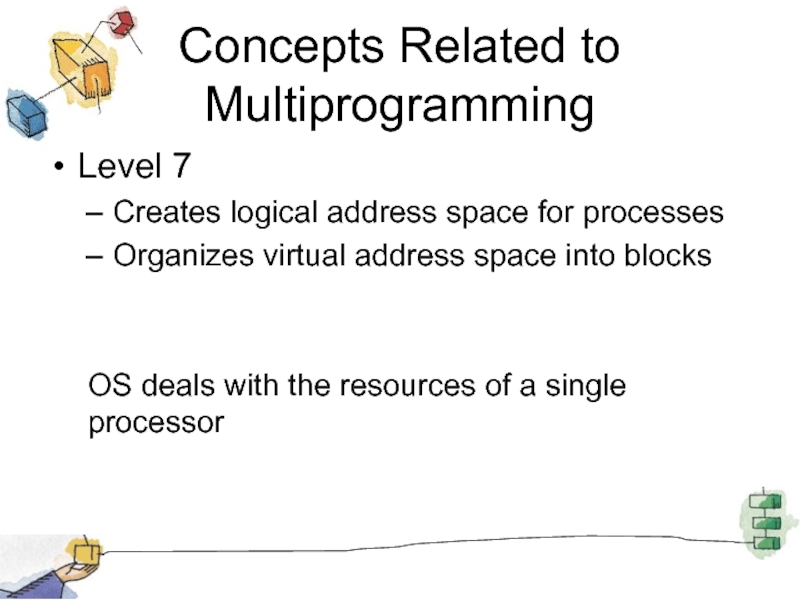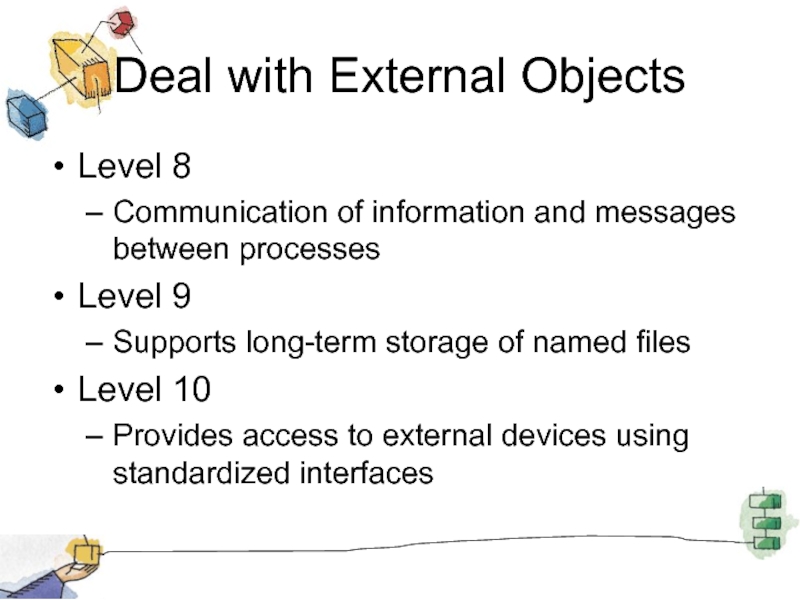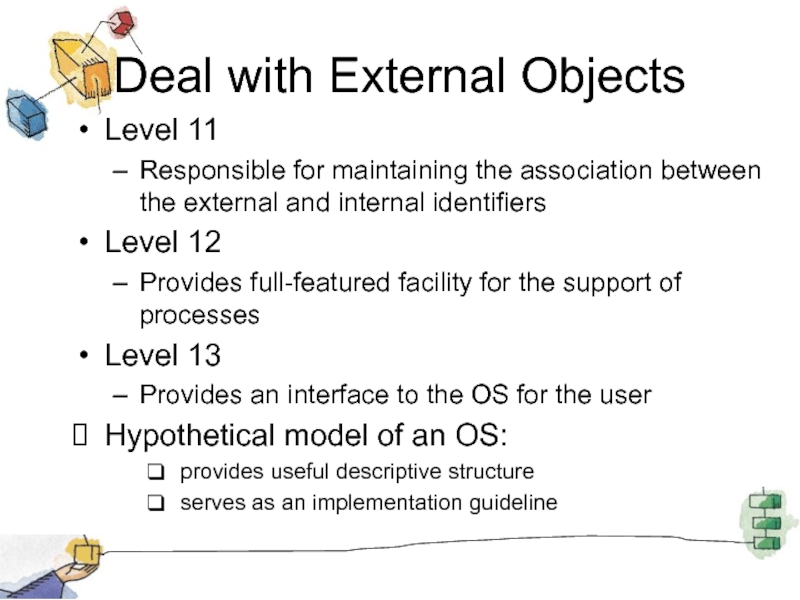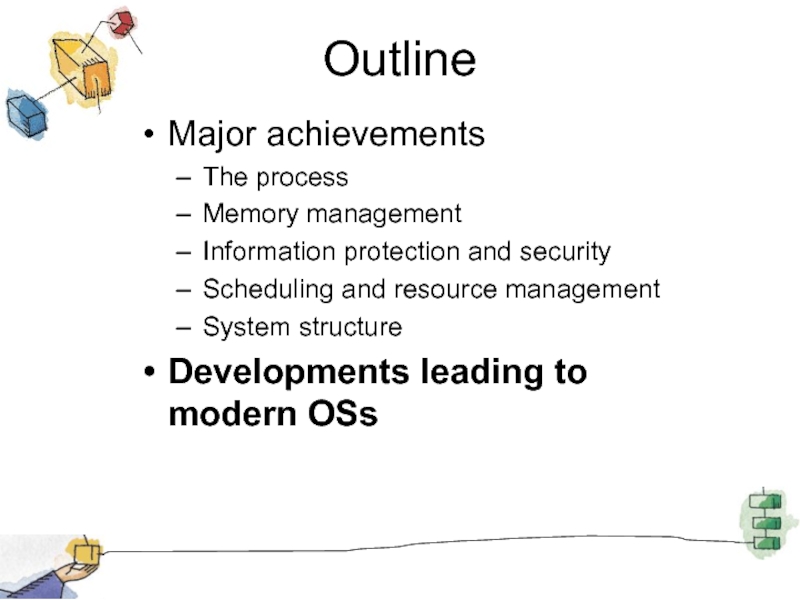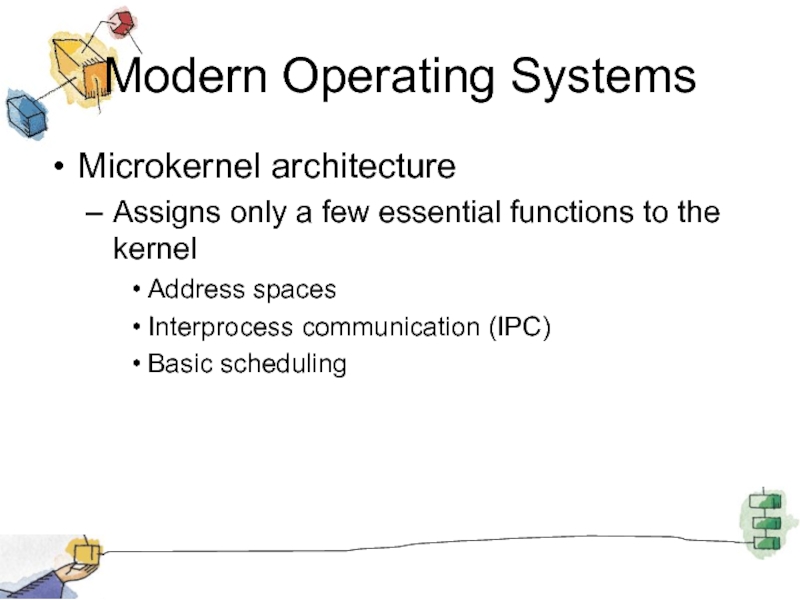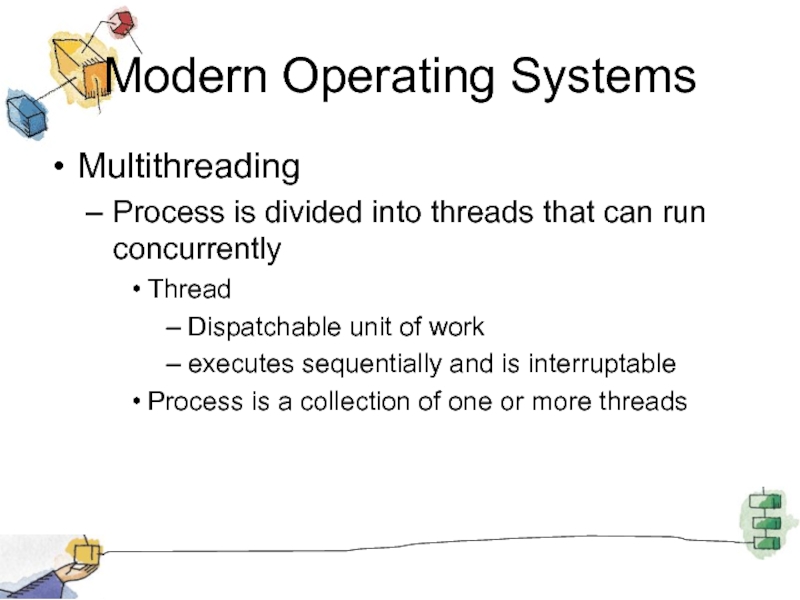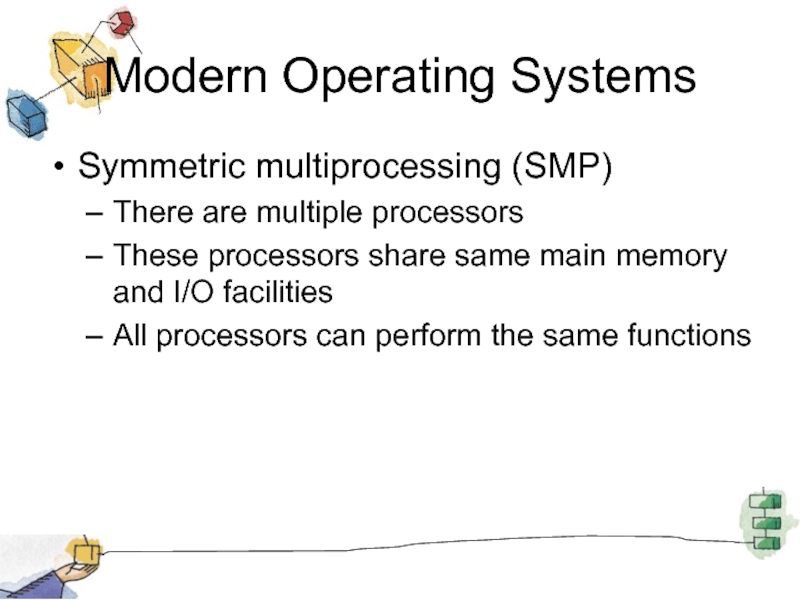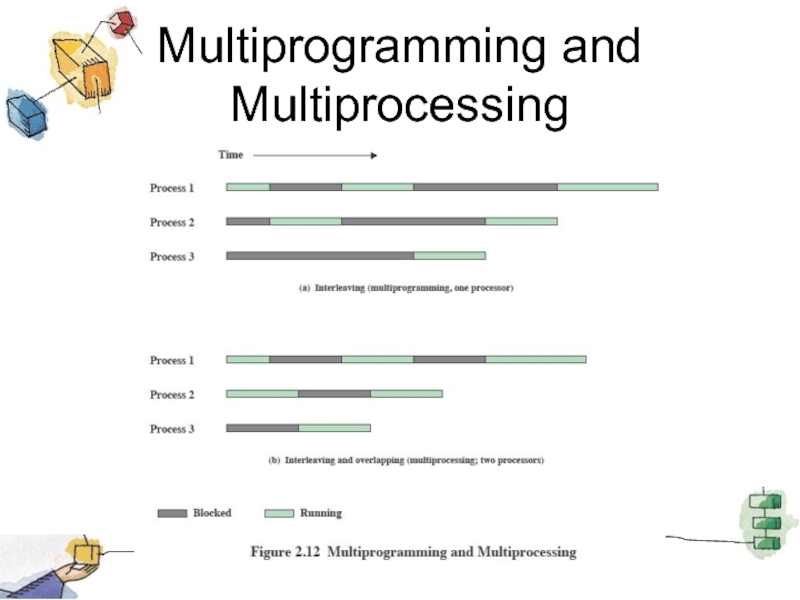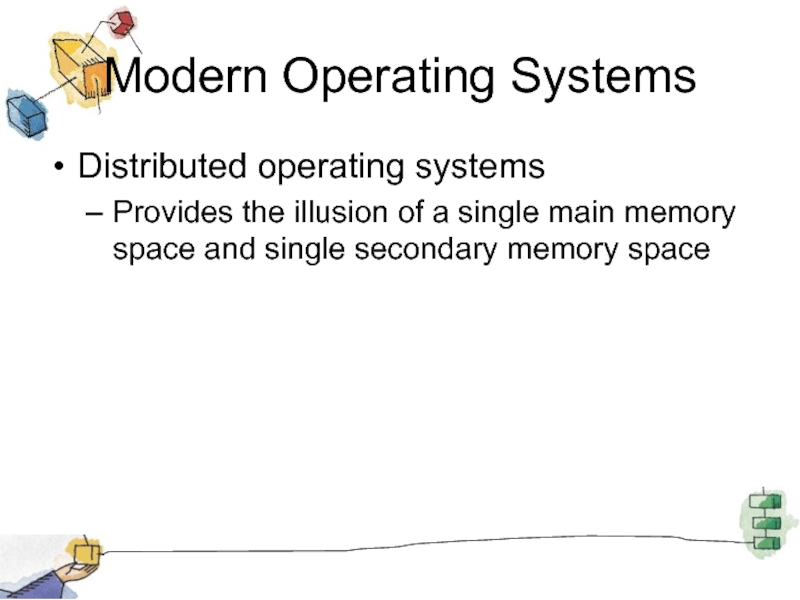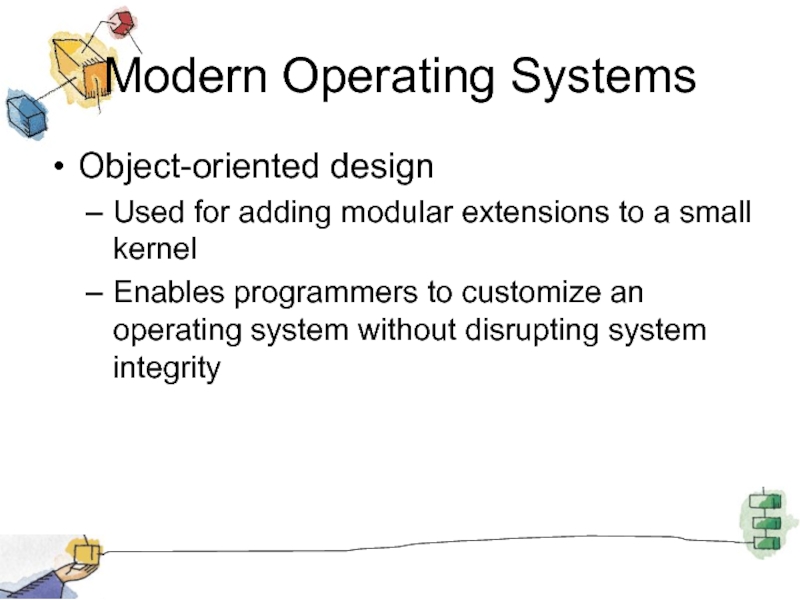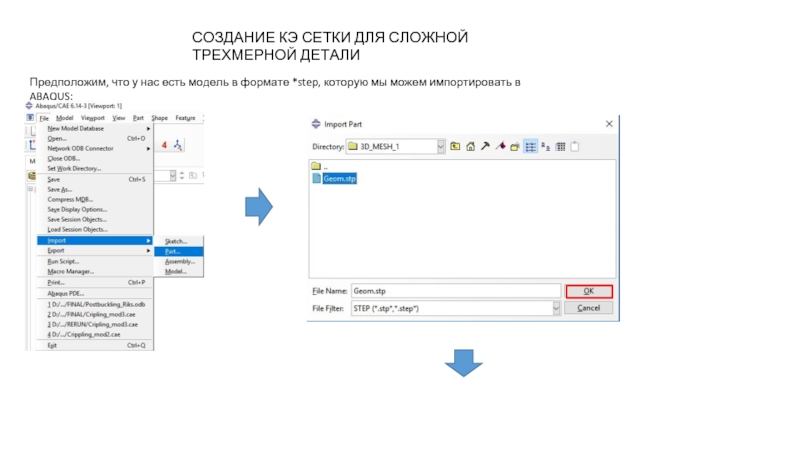Operating Systems:
Internals and Design Principles, 6/E
William Stallings
- Главная
- Разное
- Дизайн
- Бизнес и предпринимательство
- Аналитика
- Образование
- Развлечения
- Красота и здоровье
- Финансы
- Государство
- Путешествия
- Спорт
- Недвижимость
- Армия
- Графика
- Культурология
- Еда и кулинария
- Лингвистика
- Английский язык
- Астрономия
- Алгебра
- Биология
- География
- Детские презентации
- Информатика
- История
- Литература
- Маркетинг
- Математика
- Медицина
- Менеджмент
- Музыка
- МХК
- Немецкий язык
- ОБЖ
- Обществознание
- Окружающий мир
- Педагогика
- Русский язык
- Технология
- Физика
- Философия
- Химия
- Шаблоны, картинки для презентаций
- Экология
- Экономика
- Юриспруденция
Operating System Overview презентация
Содержание
- 1. Operating System Overview
- 2. Outline Major achievements The process Memory management
- 3. Major Achievements There have been 5 major
- 4. Outline Major achievements The process Memory management
- 5. Process This term was first used by
- 6. Difficulties with Designing System Software Problems in
- 7. Difficulties with Designing System Software Problems in
- 8. Difficulties with Designing System Software Problems in
- 9. Difficulties with Designing System Software The principal
- 10. Difficulties with Designing System Software The design
- 11. Difficulties with Designing System Software Vulnerability to
- 12. Difficulties with Designing System Software Improper synchronization
- 13. Difficulties with Designing System Software Nondeterminate program
- 14. Process Systematic way to monitor and control
- 15. Process The execution context, or process state
- 16. Process The context includes all the information
- 17. Typical process implementation Two processes A and
- 18. Typical process implementation The process index register
- 19. Typical process implementation The base register is
- 20. Process Process is realized as a data
- 21. Outline Major achievements The process Memory management
- 22. Memory Management Storage management responsibilities: Process isolation
- 23. Virtual Memory OS meets these requirements with
- 24. Paging Processes vary in size If
- 25. Virtual Memory
- 26. Virtual Memory Addressing
- 27. Outline Major achievements The process Memory management
- 28. Information Protection and Security Availability Concerned with
- 29. Information Protection and Security Data integrity Protection
- 30. Outline Major achievements The process Memory management
- 31. Scheduling and Resource Management Fairness Give equal
- 32. Scheduling and Resource Management Efficiency Maximize throughput,
- 33. Key Elements of an Operating System
- 34. Outline Major achievements The process Memory management
- 35. System Structure View the system as a
- 36. Levels Level 1 Electronic circuits Objects are
- 37. Levels Level 3 Adds the concept of
- 38. Concepts Related to Multiprogramming Level 5 Process
- 39. Concepts Related to Multiprogramming Level 7 Creates
- 40. Deal with External Objects Level 8 Communication
- 41. Deal with External Objects Level 11 Responsible
- 42. Outline Major achievements The process Memory management
- 43. Modern Operating Systems Microkernel architecture Assigns only
- 44. Modern Operating Systems Multithreading Process is divided
- 45. Modern Operating Systems Symmetric multiprocessing (SMP) There
- 46. Multiprogramming and Multiprocessing
- 47. Modern Operating Systems Distributed operating systems Provides
- 48. Modern Operating Systems Object-oriented design Used for
Слайд 1Lecture 4
Operating System Overview. Part 2
Patricia Roy
Manatee Community College, Venice, FL
©2008,
Prentice Hall
Слайд 2Outline
Major achievements
The process
Memory management
Information protection and security
Scheduling and resource management
System structure
Developments
leading to modern OSs
Слайд 3Major Achievements
There have been 5 major advances in the development of
OSs:
Processes
Memory management
Information protection and security
Scheduling and resource management
System structure
Processes
Memory management
Information protection and security
Scheduling and resource management
System structure
Слайд 4Outline
Major achievements
The process
Memory management
Information protection and security
Scheduling and resource management
System structure
Developments
leading to modern OSs
Слайд 5Process
This term was first used by the designers of Multics in
the 1960s
Definitions
A program in execution
An instance of a program running on a computer
The entity that can be assigned to and executed on a processor
A unit of activity characterized by
a single sequential thread of execution
a current state
an associated set of system resources
Definitions
A program in execution
An instance of a program running on a computer
The entity that can be assigned to and executed on a processor
A unit of activity characterized by
a single sequential thread of execution
a current state
an associated set of system resources
Слайд 6Difficulties with Designing System Software
Problems in timing and synchronization that contributed
to the development of the concept of the process:
Multiprogramming
Key design objective: to keep the processor and I/O devices simultaneously busy to achieve maximum efficiency.
Key mechanism: in response to signals indicating the completion of I/O transactions, the processor is switched among the various programs residing in main memory.
Multiprogramming
Key design objective: to keep the processor and I/O devices simultaneously busy to achieve maximum efficiency.
Key mechanism: in response to signals indicating the completion of I/O transactions, the processor is switched among the various programs residing in main memory.
Слайд 7Difficulties with Designing System Software
Problems in timing and synchronization that contributed
to the development of the concept of the process:
General purpose time-sharing
Key design objective: to be responsive to the needs of the individual user be able to support many users simultaneously
Key mechanism: typical user needs an average 2 seconds of processing time per minute, then close to 30 such users should be able to share the same system without noticeable interference
General purpose time-sharing
Key design objective: to be responsive to the needs of the individual user be able to support many users simultaneously
Key mechanism: typical user needs an average 2 seconds of processing time per minute, then close to 30 such users should be able to share the same system without noticeable interference
Слайд 8Difficulties with Designing System Software
Problems in timing and synchronization that contributed
to the development of the concept of the process:
Real-time transaction processing systems
Key design objective: a number of users are entering queries or updates against a database (example: an airline reservation system)
Key mechanism: response time is very important
Real-time transaction processing systems
Key design objective: a number of users are entering queries or updates against a database (example: an airline reservation system)
Key mechanism: response time is very important
Слайд 9Difficulties with Designing System Software
The principal tool available to system programmers
in developing the early multiprogramming and multiuser interactive systems – interrupt
the activity of any job could be suspended
by a definite event or an I/O completion
the processor would
save some sort of context (PC and other registers)
branch to an interrupt-handling routine
an interrupt-handling routine would
determine the nature of the interrupt
process the interrupt
resume user processing with the interrupted job
the activity of any job could be suspended
by a definite event or an I/O completion
the processor would
save some sort of context (PC and other registers)
branch to an interrupt-handling routine
an interrupt-handling routine would
determine the nature of the interrupt
process the interrupt
resume user processing with the interrupted job
Слайд 10Difficulties with Designing System Software
The design turned out to be remarkably
difficult
many jobs in progress at any one time
each job involved numerous steps to be performed in sequence
=> it became impossible to analyze all of the
possible combinations of sequences of events
The absence of
some systematic means of coordination and cooperation among activities
Programmers used methods based on their understanding of the environment that the OS had to control
many jobs in progress at any one time
each job involved numerous steps to be performed in sequence
=> it became impossible to analyze all of the
possible combinations of sequences of events
The absence of
some systematic means of coordination and cooperation among activities
Programmers used methods based on their understanding of the environment that the OS had to control
Слайд 11Difficulties with Designing System Software
Vulnerability to subtle programming errors
Effects of these
errors could be observed only when certain relatively rare sequences of actions occurred
These errors were difficult to diagnose they needed to be distinguished from application software errors and hardware errors
Even when the error was detected, it was difficult to determine the cause, because the precise conditions under which the errors appeared were very hard to reproduce
There 4 main causes of such errors
These errors were difficult to diagnose they needed to be distinguished from application software errors and hardware errors
Even when the error was detected, it was difficult to determine the cause, because the precise conditions under which the errors appeared were very hard to reproduce
There 4 main causes of such errors
Слайд 12Difficulties with Designing System Software
Improper synchronization -
a routine must be
suspended awaiting an event elsewhere in the system
a signal from some other routine is required
improper design of the signaling mechanism: lost signals, duplicate signals received
Failed mutual exclusion
multiple programs using shared resources at the same time
mechanism that permits only one routine at a time to perform an update against file
a signal from some other routine is required
improper design of the signaling mechanism: lost signals, duplicate signals received
Failed mutual exclusion
multiple programs using shared resources at the same time
mechanism that permits only one routine at a time to perform an update against file
Слайд 13Difficulties with Designing System Software
Nondeterminate program operation
the results of a particular
program depend on the input to that program
not on the activities of other programs in shared memory (overwriting common memory areas)
the order in which various programs are scheduled may affect the outcome of any particular program
Deadlocks
two or more programs hung up waiting for each other
not on the activities of other programs in shared memory (overwriting common memory areas)
the order in which various programs are scheduled may affect the outcome of any particular program
Deadlocks
two or more programs hung up waiting for each other
Слайд 14Process
Systematic way to monitor and control the various programs executing on
the processor
is needed to tackles these problems
Process consists of three components
an executable program
the associated data needed by the program
variables
work space
buffers, etc.
the execution context of the program
is needed to tackles these problems
Process consists of three components
an executable program
the associated data needed by the program
variables
work space
buffers, etc.
the execution context of the program
Слайд 15Process
The execution context, or process state
is the internal data by which
the OS is able to supervise and control the process
This internal information is separated from the process
because the OS has information not permitted to the process
This internal information is separated from the process
because the OS has information not permitted to the process
Слайд 16Process
The context includes all the information that
the OS needs to manage
the process
the processor needs to execute the process properly
The context includes
the contents of the various processor registers (PC, data registers)
information of use to the OS
priority of the process
whether the process is waiting for the completion of a particular I/O event
the processor needs to execute the process properly
The context includes
the contents of the various processor registers (PC, data registers)
information of use to the OS
priority of the process
whether the process is waiting for the completion of a particular I/O event
Слайд 17Typical process implementation
Two processes A and B exist in the portions
of main memory
A block of memory is allocated to each process, contains
program
data
context
An OS builds and maintains a process list with one entry for each process
a pointer to the location of the block of memory that contains the process
a part or all of the execution context of the process
A block of memory is allocated to each process, contains
program
data
context
An OS builds and maintains a process list with one entry for each process
a pointer to the location of the block of memory that contains the process
a part or all of the execution context of the process
Слайд 18Typical process implementation
The process index register contains the index into the
process currently controlling the processor
The program counter points to the next instruction in the process to be executed
The base register and limit register define the region in memory occupied by the process
The program counter points to the next instruction in the process to be executed
The base register and limit register define the region in memory occupied by the process
Слайд 19Typical process implementation
The base register is the starting address of the
region in the memory
The limit register is the size of the region (in bytes or words)
The program counter and all data references are
interpreted relative to the base register
must not exceed the value in the limit register
this prevents interprocess interference
The limit register is the size of the region (in bytes or words)
The program counter and all data references are
interpreted relative to the base register
must not exceed the value in the limit register
this prevents interprocess interference
Слайд 20Process
Process is realized as a data structure
Process can be executing or
awaiting execution
The entire state of the process at any instant is contained in its context
This structure allows the development of powerful techniques for ensuring coordination and cooperation among processes
The entire state of the process at any instant is contained in its context
This structure allows the development of powerful techniques for ensuring coordination and cooperation among processes
Слайд 21Outline
Major achievements
The process
Memory management
Information protection and security
Scheduling and resource management
System structure
Developments
leading to modern OSs
Слайд 22Memory Management
Storage management responsibilities:
Process isolation
Automatic allocation and management
Support of modular programming
Protection
and access control
Long-term storage
Long-term storage
Слайд 23Virtual Memory
OS meets these requirements with virtual memory and file system
facilities.
File system implements long-term store
Information stored in named objects called files
Virtual memory allows programs to address memory from a logical point of view, without regard to the amount of main memory physically available
File system implements long-term store
Information stored in named objects called files
Virtual memory allows programs to address memory from a logical point of view, without regard to the amount of main memory physically available
Слайд 24Paging
Processes vary in size
If the processor switches among a number
of processes, it is difficult to pack them compactly into main memory
Paging systems allow process to be comprised of a number of fixed-size blocks, called pages
Virtual address is a page number and an offset within the page
Each page may be located anywhere in main memory
Real address or physical address is the main memory address
Paging systems allow process to be comprised of a number of fixed-size blocks, called pages
Virtual address is a page number and an offset within the page
Each page may be located anywhere in main memory
Real address or physical address is the main memory address
Слайд 27Outline
Major achievements
The process
Memory management
Information protection and security
Scheduling and resource management
System structure
Developments
leading to modern OSs
Слайд 28Information Protection and Security
Availability
Concerned with protecting the system against interruption
Confidentiality
Assuring that
users cannot read data for which access is unauthorized
Слайд 29Information Protection and Security
Data integrity
Protection of data from unauthorized modification
Authenticity
Concerned with
the proper verification of the identity of users and the validity of messages or data
Слайд 30Outline
Major achievements
The process
Memory management
Information protection and security
Scheduling and resource management
System structure
Developments
leading to modern OSs
Слайд 31Scheduling and Resource Management
Fairness
Give equal and fair access to resources
Differential responsiveness
Discriminate
among different classes of jobs
Слайд 32Scheduling and Resource Management
Efficiency
Maximize throughput, minimize response time, and accommodate as
many uses as possible
Слайд 34Outline
Major achievements
The process
Memory management
Information protection and security
Scheduling and resource management
System structure
Developments
leading to modern OSs
Слайд 35System Structure
View the system as a series of levels
Each level performs
a related subset of functions
Each level relies on the next lower level to perform more primitive functions
This decomposes a problem into a number of more manageable subproblems
Each level relies on the next lower level to perform more primitive functions
This decomposes a problem into a number of more manageable subproblems
Слайд 36Levels
Level 1
Electronic circuits
Objects are registers, memory cells, and logic gates
Operations are
clearing a register or reading a memory location
Level 2
Processor’s instruction set
Operations such as add, subtract, load, and store
Level 2
Processor’s instruction set
Operations such as add, subtract, load, and store
Слайд 37Levels
Level 3
Adds the concept of a procedure or subroutine, plus call/return
operations
Level 4
Interrupts
Not part of the OS, constitute the processor hardware
Level 4
Interrupts
Not part of the OS, constitute the processor hardware
Слайд 38Concepts Related to Multiprogramming
Level 5
Process as a program in execution
Suspend and
resume processes
Level 6
Secondary storage devices
Transfer of blocks of data
Level 6
Secondary storage devices
Transfer of blocks of data
Слайд 39Concepts Related to Multiprogramming
Level 7
Creates logical address space for processes
Organizes virtual
address space into blocks
OS deals with the resources of a single processor
OS deals with the resources of a single processor
Слайд 40Deal with External Objects
Level 8
Communication of information and messages between processes
Level
9
Supports long-term storage of named files
Level 10
Provides access to external devices using standardized interfaces
Supports long-term storage of named files
Level 10
Provides access to external devices using standardized interfaces
Слайд 41Deal with External Objects
Level 11
Responsible for maintaining the association between the
external and internal identifiers
Level 12
Provides full-featured facility for the support of processes
Level 13
Provides an interface to the OS for the user
Hypothetical model of an OS:
provides useful descriptive structure
serves as an implementation guideline
Level 12
Provides full-featured facility for the support of processes
Level 13
Provides an interface to the OS for the user
Hypothetical model of an OS:
provides useful descriptive structure
serves as an implementation guideline
Слайд 42Outline
Major achievements
The process
Memory management
Information protection and security
Scheduling and resource management
System structure
Developments
leading to modern OSs
Слайд 43Modern Operating Systems
Microkernel architecture
Assigns only a few essential functions to the
kernel
Address spaces
Interprocess communication (IPC)
Basic scheduling
Address spaces
Interprocess communication (IPC)
Basic scheduling
Слайд 44Modern Operating Systems
Multithreading
Process is divided into threads that can run concurrently
Thread
Dispatchable
unit of work
executes sequentially and is interruptable
Process is a collection of one or more threads
executes sequentially and is interruptable
Process is a collection of one or more threads
Слайд 45Modern Operating Systems
Symmetric multiprocessing (SMP)
There are multiple processors
These processors share same
main memory and I/O facilities
All processors can perform the same functions
All processors can perform the same functions
Слайд 47Modern Operating Systems
Distributed operating systems
Provides the illusion of a single main
memory space and single secondary memory space
Слайд 48Modern Operating Systems
Object-oriented design
Used for adding modular extensions to a small
kernel
Enables programmers to customize an operating system without disrupting system integrity
Enables programmers to customize an operating system without disrupting system integrity

